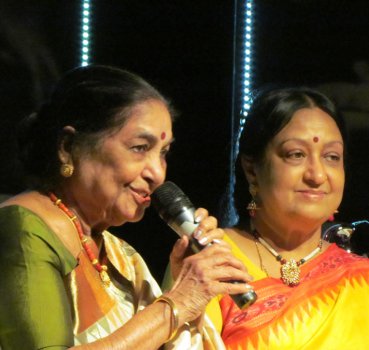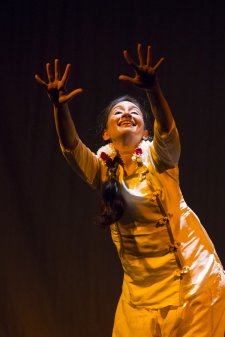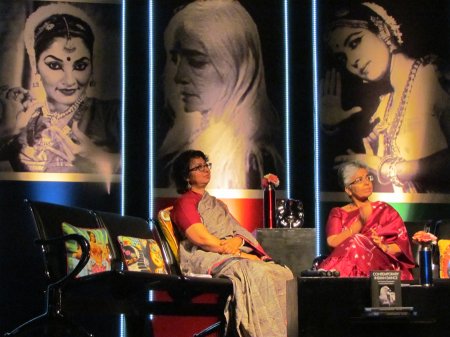
|   |

|   |
Natya Darshan Seminar EPIC WOMEN - Conference / Performance conclave DAY 3 - Femininity and Feminism in Modern Epic Women - Kiran Rajagopalan e-mail: kiran.rajagopalan@gmail.com Photos: Lalitha Venkat December 24, 2012 What a delightful way to start the final day of “Epic Women” with soothing music and a delicious breakfast! The early morning session ‘Light at the Edge of the World’ featured school children beautifully singing a Rabindranath Tagore sangeet and a pasuram from Andal’s Tiruppavai. Pianist Anil Srinivasan and Carnatic violinist Viji Krishnan also gave a small concert in which they skillfully elaborated the ragas Kalyani, Lathangi, Purvi Kalyani and Hamir Kalyani and Bharathiar’s “Theeratha Vilayattu Pillai.” The rest of the morning consisted of Kartik Fine Arts’s award ceremony and the usual performances and lectures. Young Kuchpudi dancer Deepika Potarazu received the ‘Natya Chudar’ and legendary teacher-choreographer Dr. Maya Rao was honored with a lifetime achievement award. Dr. Padma Subrahmanyam and Leela Venkataraman then spoke candidly about their experiences of Maya Rao’s exceptional artistry. A short film of 8 minutes on Guru Maya Rao was screened. Dr. Anita Ratnam and L. Sabaretnam issued the vote of thanks before proceeding to the other sessions.  Dr. Padma Subrahmanyam, Dr. Maya Rao, L. Sabaretnam, Dr. Anita Ratnam  Dr. Maya Rao, Dr. Padma Subrahmanyam Dr. Andrée Grau’s lecture on Mrinalini Sarabhai focused primarily on how her eclectic upbringing and “cosmopolitan patriotism” influenced her choreographic process. Born into a family of social activists and freedom fighters, Mrinalini was formally schooled in Santiniketan, Switzerland, and the United States. She also learnt classical dance from traditional gurus - Bharatanatyam from Meenakshisundaram Pillai and Kathakali from Thakazhi Kunchu Kurup. Interestingly, she has been working on her own innovative choreographies since 1949 when she established Darpana Academy of Performing Arts. While her early works largely dealt with human nature, she gradually shifted her artistic inclinations toward prevalent social issues in India. Dr. Grau also showed a brief excerpt from a documentary on Mrinalini Sarabhi’s life.  Anusha Subramanyam (Photo: Vipul Sangoi) Anusha Subramanyam celebrated another modern epic woman in her performance piece on Aung San Suu Kyi, the remarkable Burmese freedom fighter. Aptly titled “Golden Peacock,” Anusha graphically depicted Suu Kyi’s indomitable spirit and her struggle for democracy while Burma floundered under military rule. She also touched upon the conflict that Suu Kyi must have experienced when she placed her cause ahead of her own family. However, the most striking aspect of the piece was the symbolic use of lighting which was used to bathe the stark stage setting and Anusha’s impeccable costume in brilliant shades of gold. The final plenary session beautifully summarized the conference in a series of lectures by Dr. Ketu Katrak, Ammu Joseph, and Dr. Kalpana Ram. Dr. Katrak used the stories of Surpanakha, William Shakespeare’s Lady Macbeth, and Medea from Greek tragedy to illustrate how “dark women” in literature are driven to destruction when unbridled passion is “dangerously coupled with power and ambition.” Dr. Katrak emphasized the importance of understanding the motive behind such women’s actions even if they are despised.  Dr. Kalpana Ram, Ammu Joseph Ammu’s incisive discussion about the role of women in South Asian politics revealed an interesting phenomenon about gender and power. For example, India, Sri Lanka, and Bangladesh all have a remarkable number of powerful female politicians despite the poor status of women in the region. This discrepancy stems from the fact that high-level female politicians tend to distance themselves from grassroots female politicians. Consequently, pressing women’s issues are often sidelined, and there is an alarming deficit in female representation in the Indian government. Dr. Ram concluded the conference with an academic analysis of performance’s profound influence on basic human behavior. She examined “shared epics” with strong and distinct performing traditions associated with them. These stories, embedded in a collective consciousness over centuries, can shape behavior since people often refer to them subconsciously when facing a dilemma. They also give rise to different interpretations based on social, cultural, political, and religious factors. Why do many interpretations of Ramayana remain unfinished among labor class women? Dr. Ram argued that these women purposely choose to interpret only the aspects of the story directly relevant to them. In general, this year’s ‘Natya Darshan’ was intellectually stimulating and informative. Special mention must be made of all the individuals who worked tirelessly behind the scenes to make everything so seamless. Dr. Ratnam must also be commended for her meticulous organizational skills and for her uncanny ability to bring such a diverse group of presenters and performers to Chennai. Next year’s conference will be ‘Purush,’ a continuation of Dr. Ratnam’s landmark 1995 festival at Music Academy on the global male dancer. Kiran Rajagopalan is a Bharatanatyam dancer and writer. |